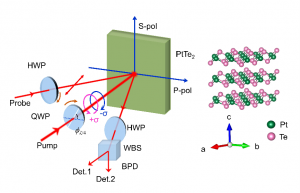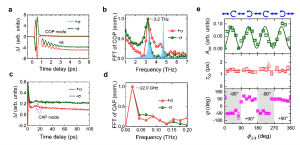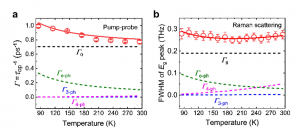Anisotropic phonon dynamics in Dirac semimetal PtTe2 thin films enabled by helicity-dependent ultrafast light excitation
USA, September 3, 2024 /EINPresswire.com/ -- Dirac semimetal PtTe2 holds great promise for next-generation low-power spintronics and optoelectronics devices. To achieve high performance in these devices, a deep study of phonon dynamics is crucial. Towards this goal, Chinese scientists, using all-optical ultrafast pump-probe and Raman scattering techniques, have discovered the generation mechanism of Eg-mode phonons driven by spin-polarized electrons and elucidated unusual dissipation process via electron-phonon scattering. This work paves the way for potential future breakthroughs in the field of spintronics and optoelectronics.
In condensed matter physics, topological Dirac semimetals have attracted great interest due to their unique electronic band structures, which provide an ideal platform for exploring topological phase transition and the low-energy excitation of quasi-particles. PtTe2, a 2D layered van der Waals material, possesses type-Ⅱ Dirac fermions with a pair of strongly tilted and anisotropic Dirac cones, exhibiting many novel quantum effects, such as de Haas-van Alphen quantum oscillations. In view of the remarkable properties, such as high charge-to-spin conversion efficiency, superior high conductivity, excellent air stability, and broadband photoresponse from the visible to terahertz range, PtTe2 has become a promising candidate for advanced spintronic and optoelectronic devices.
Phonons play an important role in determining physical properties such as electrical and thermal conductivity. Especially, the coherent phonons with in-phase collective lattice vibrations, have been recognized as an effective tool for controlling fundamental physical properties and exploring the ultrafast dynamic processes. It has been reported that coherent phonons can be utilized to transiently control the macroscopic magnetic states and achieve ultrafast phase transitions from insulator to metal states. Hence, the investigation of phonon dynamics in PtTe2 not only aids in elucidating the mechanism of ultrafast interactions between phonons and other microscopic particles in topological materials, but also serves as a crucial experimental foundation for optimizing the performance of PtTe2-based electronic devices. However, the ultrafast transient behaviors of coherent phonons in Dirac semimetal PtTe2 have been rarely reported so far, and the underlying physical mechanism have not been well understood yet.
In a new paper published in Light: Science & Applications, the collaborative research team led by Prof. Zongzhi Zhang at Fudan University and Prof. Xuefeng Wang at Nanjing University has focused on exploring the coherent phonon dynamics in Dirac semimetal PtTe2 thin films. They employed pulsed laser deposition technique to fabricate a batch of high-quality 1T-PtTe2 films, and employed the time-resolved femtosecond pump-probe technique and frequency-domain Raman spectroscopy to carry out an in-depth investigation.
In this study, researchers firstly detected coherent optical phonons (COP) of the Eg mode and coherent acoustic phonons (CAP) in the Dirac Semimetal PtTe2. By varying the helicity of pump light, they observed helicity-dependent amplitudes and phases of COP and helicity-independent CAP oscillations, unveiling the connection between the laser-excited spin-polarized electrons and COP. It provides a new pathway for the ultrafast optical modulation of coherent phonons in topological materials.
Anisotropic phonon behaviors are further demonstrated by tuning the polarization direction of the linear probe laser beam. Compared to excitation with linearly polarized light, circularly polarized light-induced COP display four-fold symmetric amplitudes and anisotropic phases. After rotating the PtTe2 film by 45°, the anisotropy phenomenon remains highly consistent, which proves that the anisotropy originates from the anisotropic distribution of the photoexcited spin-polarized electrons, rather than the crystallographic orientation of the PtTe2 crystal.
The optical phonon dissipation mechanisms in PtTe2 are further revealed. Within the experimental temperature range of 85-295 K, the time-domain ultrafast spectra display an uncommonly decreasing decay rate of Eg mode phonon with increasing temperature. This behavior is attributed to the electron-phonon scattering rather than the conventional phonon-phonon scattering, consistent with the frequency-domain results from Raman spectroscopy. According to the theoretical model, the electron-phonon coupling strength coefficient is calculated to be as high as 0.92, verifying that 1T-PtTe2 is a strongly electron-phonon coupling material.
“This work provides an in-depth understanding of the ultrafast phonon dynamics in topological Dirac semimetals for the potential applications in spintronic and optoelectronic devices.” The researchers emphasized.
DOI
10.1038/s41377-024-01540-z
Original Source URL
https://doi.org/10.1038/s41377-024-01540-z
Funding information
This work was supported by the National Key R&D Program of China (2022YFA1402404), the National Natural Science Foundation of China (12374104, 52171230, T2394473, T2394470, 62274085, 61822403 and 11874120) and the Fundamental Research Funds for the Central Universities (021014380225).
Lucy Wang
BioDesign Research
email us here
Legal Disclaimer:
EIN Presswire provides this news content "as is" without warranty of any kind. We do not accept any responsibility or liability for the accuracy, content, images, videos, licenses, completeness, legality, or reliability of the information contained in this article. If you have any complaints or copyright issues related to this article, kindly contact the author above.



